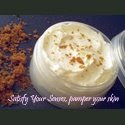flowering perennial, native of the Mediterranean region
and central and southwest Asia. It is cultivated widely
for the sweet taproot that grows to a depth of four ft (1.2
m). Licorice is a hardy plant that thrives in full sun or
partial shade and prefers rich, moist soil. It may grow to
a height of 3-7 ft (1-2 m). The wrinkled, brown root has
yellow interior flesh and is covered with a tangle of
rootlets branching from the stolons. The aerial parts of
the plant are erect and branching with round stems that
become somewhat angular near the top. The leaves are
alternate, odd, and pinnate, dividing into as many as
eight pairs of oblong leaflets. Licorice blossoms in late
summer. The sweet-pea like flowers grow in clusters
forming in the angle where the stem joins the branch.
The maroon colored seed pods are about 1-2 in (3-5 cm)
long and contain one to six kidney-shaped seeds
Licorice is a sweet and soothing herb that has been
appreciated for its medicinal qualities for thousands of
years. Hippocrates named the herb glukos riza, or sweet
root. Several species of this member of the Leguminosae,
or pea, family, are used medicinally. Glycyrrhiza glabra,
also known as sweet wood or sweet licorice, is cited first
in most herbals. Chinese licorice, G. uralenis or G. viscida,
known as the peacemaker, was included in the Chinese
classic herbal Pen Tsao Ching over 2,000 years ago,
and is believed to promote longevity. An American variety,
G. lepidota or wild licorice, was a common Native
American remedy and was also used by early settlers.
Dominican friars brought the herb to England in the sixteenth
century. The abbess Hildegard of Bingen added
licorice to her materia medica, and this well-loved herb
was a favorite of German and English herbalists.
General use
The medicinal benefits of licorice root have been
studied extensively, and its use in traditional medicine is
well documented. Licorice is an expectorant, helpful in
the treatment of upper respiratory tract catarrh. The root
extract is demulcent, and commonly used as a component
of many medicinal syrups and drops providing relief
to a sore throat and for coughs. The glycoside glycyrrhizin,
found in the root, is more than 50 times as
sweet as sucrose. Glycyrrhizin, which becomes glycyrrhizic
acid when ingested, has been credited with
much of the pharmacological action of licorice. The herb
is also effective as a mild laxative, cleansing the colon.
Licorice is a liver tonic and is used as an anti-inflammatory
medicine, useful in the treatment of arthritis. Along
with other herbs, licorice is used to treat muscle spasms.
It also acts to reduce stomach acid and relieves heartburn.
Other active chemical constituents in licorice root
include asparagine, flavonoids and isoflavonoids, chalcones,
coumarins, sterols, and triterpenoid saponins.
Studies have shown that licorice also stimulates the production
of interferon.
Licorice preparations have been used in the healing of
peptic ulcers. The demulcent action of the root extract
coats and soothes the ulcerated tissue. Licorice also has a
beneficial effect on the endocrine system and is helpful in
treatment of problems with the adrenal gland, such as Addison’s
disease. Phytochemicals in the root act similarly to
and stimulate the secretion of the body’s natural adrenal
cortex hormone, aldosterone. This sweet herb also has antibacterial
action and is beneficial in treatment of hypoglycemia.
Licorice increases bile flow and acts to lower
blood cholesterol levels. Licorice root, when boiled to extract
its sweetness, has been used traditionally in candy
making. Commercially it is a flavoring in beer, soft drinks,
and tobacco. Singers chew the root to ease throat irritation
and to strengthen their voice. Many women’s herbal formulas
include licorice for its estrogenic properties as an
aid to normalize and regulate hormone production during
menopause; however, some recent studies indicate that
licorice does not have the estrogenic qualities that have
been attributed to it. Licorice is frequently used in medicinal
compounds with other herbs. In Chinese medicine,
this herb is always used in compound, as it can minimize
the bitter taste of some herbal components, and help to
blend and harmonize the entire mixture.
More recently, licorice has been found to offer some
protection against cardiovascular disease. A team of Israeli
researchers found that licorice root extract added to
the diet lowers blood cholesterol levels as well as the
rate of oxidation in cardiovascular tissue.
Licorice also shows promise as a possible chemopreventive
against cancer. Glycyrrhizin, the glycoside
credited with many of the beneficial effects of licorice,
appears to inhibit the growth of cancer cells as well. In
addition, a new polyphenol compound isolated from
licorice root has been found to induce apoptosis, or selfdestruction,
in human prostate and breast tumor cells.
Preparations
The dried root is used in medicinal preparations.
Harvest the taproot of three- to four-year-old plants in
late autumn. Washed and dried, the root may be stored
intact until needed for a preparation.
Decoction: Combine one teaspoonful of dried root,
powdered or diced, for each cup of non-chlorinated water.
Bring to boil, lower heat and simmer for 10-15 minutes.
Dosage is three cups per day. Prepare fresh decoction daily.
Tincture: Combine one part dried root, powdered or
diced, with five parts of brandy or vodka in a glass container.
A 50/50 alcohol to water ratio is optimal. Seal the
container with an airtight lid. Leave to macerate in a
darkened place for two weeks. Shake daily. Strain the
mixture through a cheesecloth or muslin bag and pour
into a dark bottle for storage up to two years. Dosage is
one to three milliliters of the tincture three times a day.
Precautions
People should avoid using licorice in large doses for
long periods of time. This herbal remedy should be used
for no longer than four to six weeks without medical advice.
Pregnant women should not use the herb. Persons
with high blood pressure or kidney disease should not
use licorice, nor should those with cholestatic liver disorders
or cirrhosis.
Side effects
Excessive use of the herbal extract may raise blood
pressure, cause water retention, headache, and potassium
loss; however, for persons on high potassium, lowsodium
diets, this may not be a problem. Licorice taken
in its natural form, such as chewing the root, may mitigate
the side effect of water retention because of the high
presence of the plant constituent asparagine. Deglycyrrhizinated
licorice extract is commercially available
for treatment of peptic ulcer and eliminates side effects
possible with other licorice preparations.
Interactions
When licorice is used while taking thiazide diuretic
medications, this may exacerbate potassium loss. Sensitivity
to digitalis glycosides may increase with loss of potassium.

Resources
BOOKS
Blumenthal, Mark. The Complete German Commission E Mongraphs,
Therapeutic Guide to Herbal Medicines. Massachusetts:
Integrative Medicine Communications, 1998.
Bown, Deni. The Herb Society of America, Encyclopedia of
Herbs And Their Uses. New York: D.K. Publishing, Inc.,
1995.
Gladstar, Rosemary. Herbal Healing for Women. New York,
Simon & Schuster, 1993.
Kowalchik, Claire, and William H. Hylton. Rodale’s Illustrated
Encyclopedia of Herbs. Pennsylvania: Rodale Press, 1987.
Mabey, Richard. The New Age Herbalist. New York: Simon &
Schuster, Inc., 1998.
PERIODICALS
Amato, P., S. Christophe, and P. L. Mellon. “Estrogenic Activity
of Herbs Commonly Used as Remedies for Menopausal
Symptoms.” Menopause 9 (March-April 2002): 145-150.
Fuhrman, B., N. Volkova, M. Kaplan, et al. “Antiatherosclerotic
Effects of Licorice Extract Supplementation on Hypercholesterolemic
Patients: Increased Resistance of LDL to
Atherogenic Modifications, Reduced Plasma Lipid Levels,
and Decreased Systolic Blood Pressure.” Nutrition 18
(March 2002): 268-273.
Hsiang, C. Y., I. L. Lai, D. C. Chao, and T. Y. Ho. “Differential
Regulation of Activator Protein 1 Activity by Glycyrrhizin.”
Life Sciences 70 (February 22, 2002): 1643-1656.
Rafi, M. M., B. C. Vastano, N. Zhu, et al. “Novel Polyphenol
Molecule Isolated from Licorice Root (Glycyrrhiza glabra)
Induces Apoptosis, G2/M Cell Cycle Arrest, and Bcl-2
Phosphorylation in Tumor Cell Lines.” Journal of Agricultural
and Food Chemistry 50 (February 13, 2002): 677-684.











0 comments:
Post a Comment